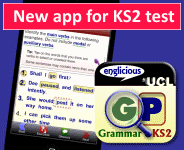Glossary
The Englicious Glossary includes the new National Curriculum glossary terms, which are shown against a white background. However, there's much more to be found here:
- we have added many entries that we feel are important, but cannot be found in the NC Glossary (e.g. connective), and
- in many cases we have added information to the (often very brief) NC entries that need further explanation (e.g. clause and phrase).
Please note that in line with our practice throughout the site, we use capital letters for function terms such as Subject, Direct Object, Indirect Object, Modifier, etc. Although this convention is not followed in the documentation published by the Department for Education we have also done so in the text that forms part of the National Curriculum Glossary.
Tip: Within our units and resources, Glossary items appear highlighted within the text. When you hover over them, or click on them in the Slideshow, a popup is generated.
base form
The basic form of a word to which inflections can be added to make other forms. E.g. clap is the base form of a verb, and is the starting point for making other forms such as clapped, clapping. This term is often used interchangeably with root word.
blended mode
A mode of communication which shows a mixture of features, some associated with spoken language and some with written language. For example, texting is often described as being a blended mode.
blending
A word formation process by which two words are blended together. Conventional examples include brunch and ginormous. More recent interesting examples include mansplain and procrastibake.
by-phrase
A preposition phrase in a passive clause which starts with by and typically identifies the agent, as in The fire was started by some campers. The by-phrase is absent in agentless passive clauses.

